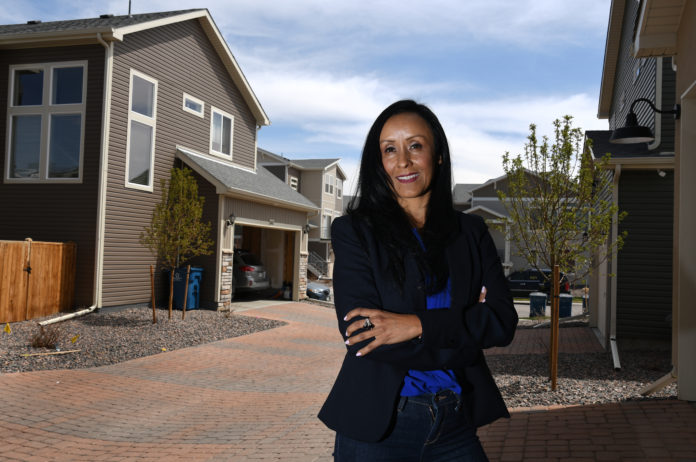Denver’s suburbs will be home to a more ethnically diverse population and a lot more aging Baby Boomers by 2040, even as the metro area’s growth slows from the torrid pace it has kept since the 1990s.
“Age is an important factor,” State Demographer Elizabeth Garner said of older people, adding that Colorado as a whole saw the second-fastest growth rate of seniors in the nation last decade. “These folks aren’t leaving — they’re staying here.”
Despite metro Denver’s slower growth over the next 20 years, it is still expected to see another 1.1 million people settling down and calling it home during that time. And a lot of those new additions will be people of color, continuing a trend that is already underway.
Every metro county except Denver has become less white over the last 20 years, according to the U.S. Census Bureau, with Adams County leading the way. Its white population dipped under 50% in 2019, while the Latino segment eclipsed 40%.
In the next 10 years, the demographer’s office pegs expects growth across metro Denver for Latinos at nearly 30% over the next 10 years, Asians at 36% and the Black population at 13%. Population growth among non-Hispanic whites? Just 4%.
“A larger share of our young adults are people of color, who are giving birth to a more diverse population,” Garner said, adding that the increases aren’t from “current migration but rather migration during the 1990s that was driven by our fast economic growth and demand for workers.”

Kathryn Scott, Special to The Denver Post
Rocio Duran stands near her home in Commerce City on April 23, 2021. Duran recently moved to this new subdivision in the northern section of the city.
“Here to thrive”
Rocio Duran is a 47-year-old immigrant from Bogota, Colombia, who runs her own executive coaching firm. Since moving to Colorado in 2012, Duran has been all over the western suburbs, calling Lakewood, Golden and Arvada home.
It was a “happy accident” — a need to be closer to Denver International Airport for her husband’s work-travel needs — that brought her family to a home in Commerce City last year.
Pointing out the window to the tidy houses lining her street, just beyond the roar of nearby E-470, Duran said one neighbor is an interracial family, one is from Venezuela, one is white and another is a gay couple.
“I really like the idea of living in a really diverse community,” she said. “I see these new neighborhoods as places to create more diverse and strong communities.”

Helen H. Richardson, The Denver Post
LEFT: Barber DB Mendes cuts Diego Leo’s hair at Mountain Fades Barbershop in Commerce City on April 28, 2021. RIGHT: Milenee Esteves takes a selfie with her boyfriend Jesus Morales as they wait to be seated for dinner at El Jardin Mexican restaurant in Commerce City the same day.
Not only is Adams County the most diverse of Denver’s suburban counties, but Commerce City itself is almost 50% Latino, according to demographic data from the Denver Regional Council of Governments. Adams County is also home to the northern stretch of Aurora, where one in five residents is foreign-born and more than 160 languages are spoken in its school district.
The state demographer’s office projects the county’s Latino population to overtake the white, non-Hispanic population in the coming decade by about 30,000 people — a growth rate of 35% versus 6% for white residents.
“We are not here to survive — we are here to thrive,” Duran said.
The age-old desire to make it in America and “be self-sustaining” is the same for the current generation of immigrants as it has been for generations past, said Maria Zubia, director of community outreach for Kids First Health Care in Adams County.
The relentless escalation in Denver’s home prices in the last several years has helped push thousands of Latinos into more affordable communities like Aurora, Commerce City, Thornton, Lakewood and Sheridan — each of which now has Latino populations exceeding 20%.
“Housing is the biggest issue for many families, regardless of race,” Zubia said.
It was for Servando Calderon when he was looking to move out of Denver 18 years ago. The owner of Servando’s Shop towing business settled on Commerce City, which was “cheap enough for us.”

Helen H. Richardson, The Denver Post
From left to right: Keila Flores, 14, Allison Menchaca, 10, Mibsam Flores, 11, and David Quirino, 12, left, swing outside of Monaco Elementary school in Commerce City on April 28, 2021.
The 45-year-old father of three said life was a challenge at the beginning because of gang activity in his neighborhood, which is near the Suncor refinery. He remembers his sons being forbidden from wearing red to school because of possible gang affiliation.
“Back in the day, it was tough,” said Calderon, who is originally from Mexico.
But he and his wife emphasized the importance of school, and his two sons are now at Colorado State University, one studying computer science and the other electrical engineering.
“For them being the first generation in our family to go to college, their mom and I are so proud,” Calderon said. Despite the refinery smell, which “never goes away,” he said, Commerce City is “a quiet and nice place.”
Undoubtedly, cultural and language barriers make things more challenging for suburban Latinos, said Maria Gonzales, who founded and heads Adelante Community Development in Commerce City to advise Latino business owners and entrepreneurs.
But, she said, “once we know how the system works, then we know.”
“We’re being resilient. We’re very hopeful, we’re optimistic,” she said. “The future is going to be Latino.”

Kathryn Scott, Special to The Denver Post
Priscilla and Ken Stenman, pictured on April 23, 2021, have found their home at the Holly Creek Retirement Community in Centennial. The couple moved into their unit eight years ago and enjoy living in the suburbs, close to their children and grandchildren.
“We got too old”
Priscilla and Ken Stenman moved to Denver’s suburbs eight years ago, when they could no longer maintain their beloved Evergreen mountain home.
“We got too old,” Priscilla Stenman said matter-of-factly while sitting next to her husband, a former Lutheran pastor, in a conference room at the Holly Creek Retirement Community in Centennial.

Priscilla, who is 84 and a year older than her husband, still drives. That allows the couple — at least pre-pandemic — to get to the light rail station and take the train to downtown Denver to attend the symphony. They also visit their three children and eight grandchildren, who live in the area.
“I’ve never really felt like we’re bound here,” she said.
The Stenmans represent a fast-growing cohort: The demographer’s office projects that people ages 80 to 84 will leap in population between now and 2030 by 83.4% — the fastest rate by far of any age bracket in Colorado.
All told, the number of 65-and-up residents in Colorado is estimated to grow by 39% by 2030, wildly outpacing any other age group in the state.
“We are seeing a growth in the 65-plus (demographic) due to the large number of Baby Boomers we attracted primarily in the 1970s and 1980s,” said Garner, the state demographer. “They have worked and lived here and now for the most part are retiring here.”
She cautions their growth trajectory is based on a lower baseline population than other age groups in Colorado. By comparison, millennials, who are between their mid-20s and late 30s are the state’s most plentiful demographic slice, with nearly 1.3 million members.
Still, the expected 10-year jump to as many as 1.2 million 65-and-up Colorado residents has Jayla Sanchez-Warren, director of the regional council of governments’ Area Agency on Aging, wondering what it means for “the way we’ve always done business?”
“The big (areas of concern) are housing and transportation and access to health care,” she added, which will differ depending on where and how seniors are living — be it at an assisted care facility, a retirement home or the house in which they raised their children.
Gretchen Lopez, 73, lives by herself in a home she bought in Castle Rock seven years ago. The Long Island, New York, native moved here from Ohio to be close to family and plans on making the house her “forever home.” Lopez, a former teacher, likes living in a place where her neighbors are in various age ranges and in different stages of life.

AAron Ontiveroz, The Denver Post
Homes in Castle Rock are pictured on Tuesday, June 11, 2019.
“For those of us who want to live in an intergenerational community, a retirement home doesn’t work for me,” she said. “Every day I know I’m going to see the two little boys across the street and I love kids. Young people bring a fresh type of energy.”
Aging in place is something Karie Erickson, executive director of Aging Resources of Douglas County, hears about a lot. And there’s a strong pull to do so, she said.
“If you’ve been in your home for 40 years, it’s comfortable,” Erickson said. “Not only do you have your memories, but you know what’s in your cupboard. When you move to a new setting, that produces a lot of stress.”
But it can spell loneliness and isolation for those no longer safe to drive, she said, and then “you quickly become dependent.” That’s especially true for seniors living in the large swath of Douglas County that is not served by the Regional Transportation District’s bus and rail network.
“I know there will be that day when I have to hang up the car keys — and I’m dreading it,” Lopez said.









